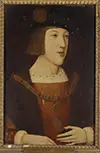Charles V: Holy Roman Emperor and Spanish Monarch
Part 1: Setting the Stage King Charles I of Spain was also Emperor Charles V of the Holy Roman Emperor and ruled both realms for nearly 40 years in the 16th Century. At its height, the territory he controlled spanned thousands of miles from Europe to the New World. 
He was born at Ghent, in Flanders, on Feb. 24, 1500. His father was Philip of Habsburg, who at the time was the heir apparent to the title of Holy Roman Emperor (since his father was the current emperor, Maximilian I). Young Charles's mother was Joanna of Trastámara, whose parents were King Ferdinand II of Aragon and Queen Isabella I of Castile. Charles grew up mostly with his aunt Margaret of Austria because his parents returned to Spain to rule their joint kingdom there. With Charles were his sisters Eleanora, Isabella, and Maria. The boy had well-known tutors, including Adrian of Utrecht, who later became Pope Adrian VI, and also studied with the Burgundian Order of the Golden Fleece, an organization focused on the virtues of medieval knighthood. When Charles was 6, his father died; the boy thus became the heir to both the throne of the Holy Roman Empire and the House of Valois-Burgundy. Significantly, Charles was in charge of the Burgundian territories, which were large and profitable. (At their height, they provided Charles with half of his annual revenue.) A decade later, his Spanish grandfather Ferdinand died and Charles became co-ruler, along with his mother. Thus, Charles was the first true King of Spain. Joanna struggled with mental problems and was determined unfit to rule and Charles took over as sole ruler of Spain. Having grown up in Flanders and not learned Spanish, he made an unfavorable impression on many of his new subjects. (He later learned Spanish, adding to his command of Dutch and French.) 
In 1519, Emperor Maximilian I died and Charles inherited his grandfather's title as ruler of Austria. He also, in 1530, won selection as Holy Roman Emperor. He styled himself Emperor Charles V and ruled all of the Holy Roman Empire and Spain for the next few decades. One of Charles's most severe challenges to his reign was the rise of Protestantism, an alternative to the Roman Catholic faith. Charles had favored the Inquisition in the Netherlands, as means of suppressing the rise of Protestantism; he knew, however, that such a strategy was unlikely to work in Austria and would certainly be resisted heavily in Germany. Most prominent of the leaders in the 1520s Charles also countenanced the establishment of the Society of Jesus, whose members (Ignatius Loyola being the most well-known) became famously known as Jesuits. The Jesuit presence was eventually known throughout much of the world. Next page > Worldwide Fame > Page 1, 2, 3 |
|
Social Studies for Kids
copyright 2002–2024
David White



 was the German monk
was the German monk 
